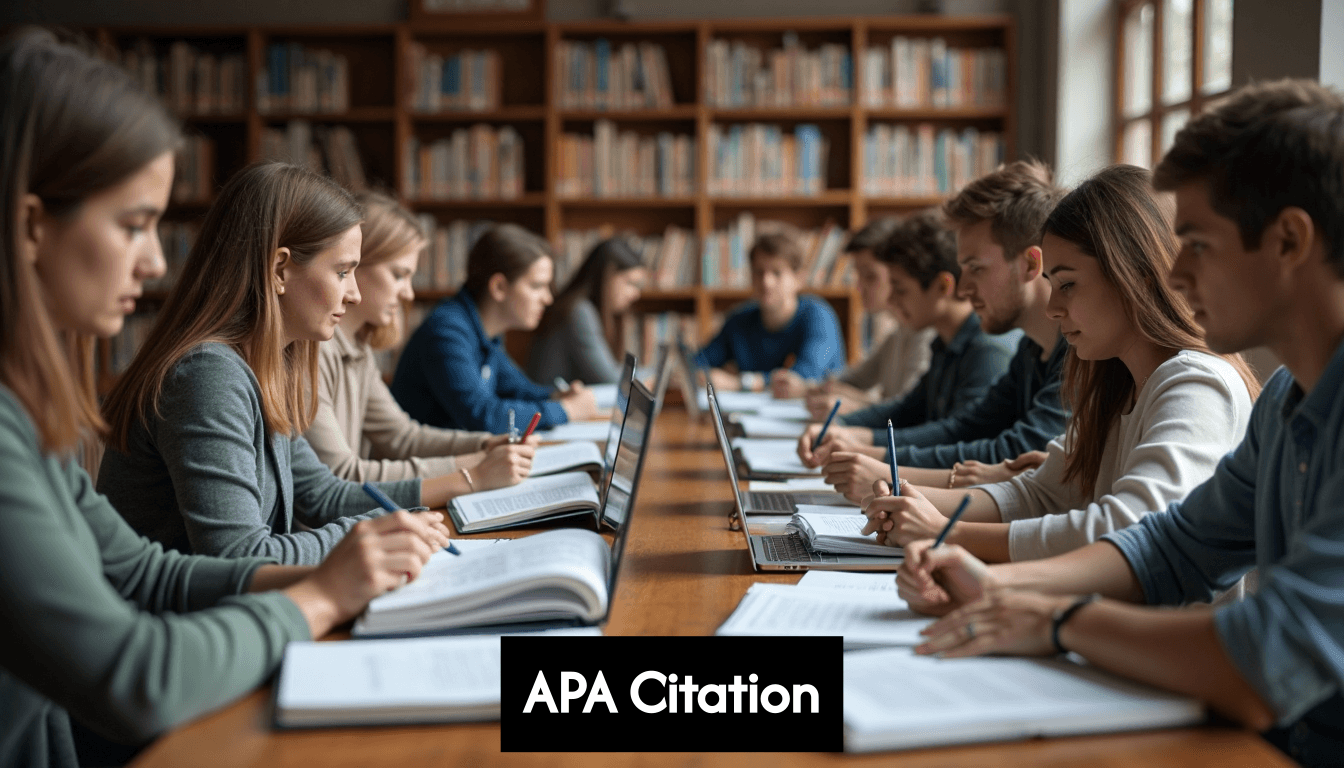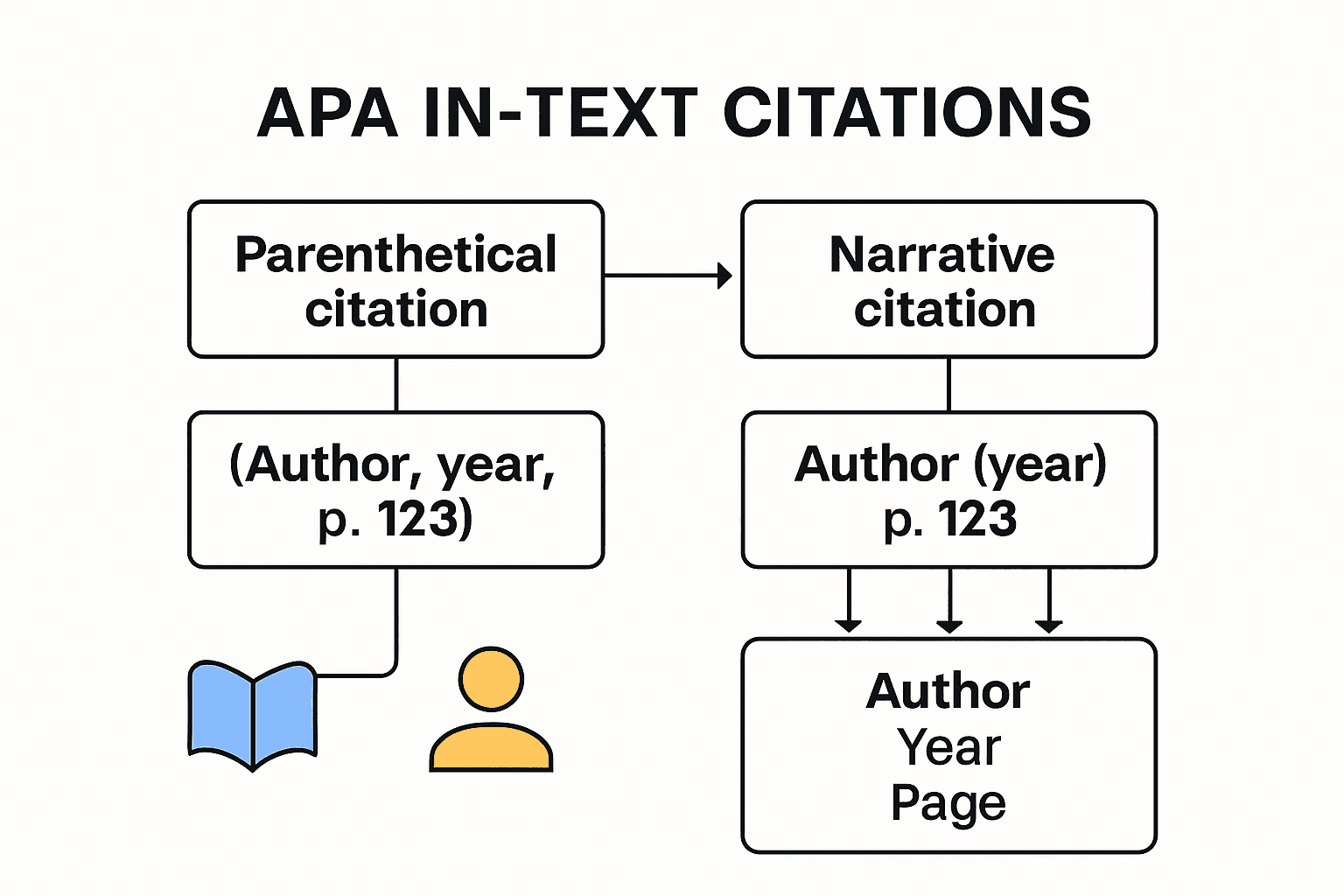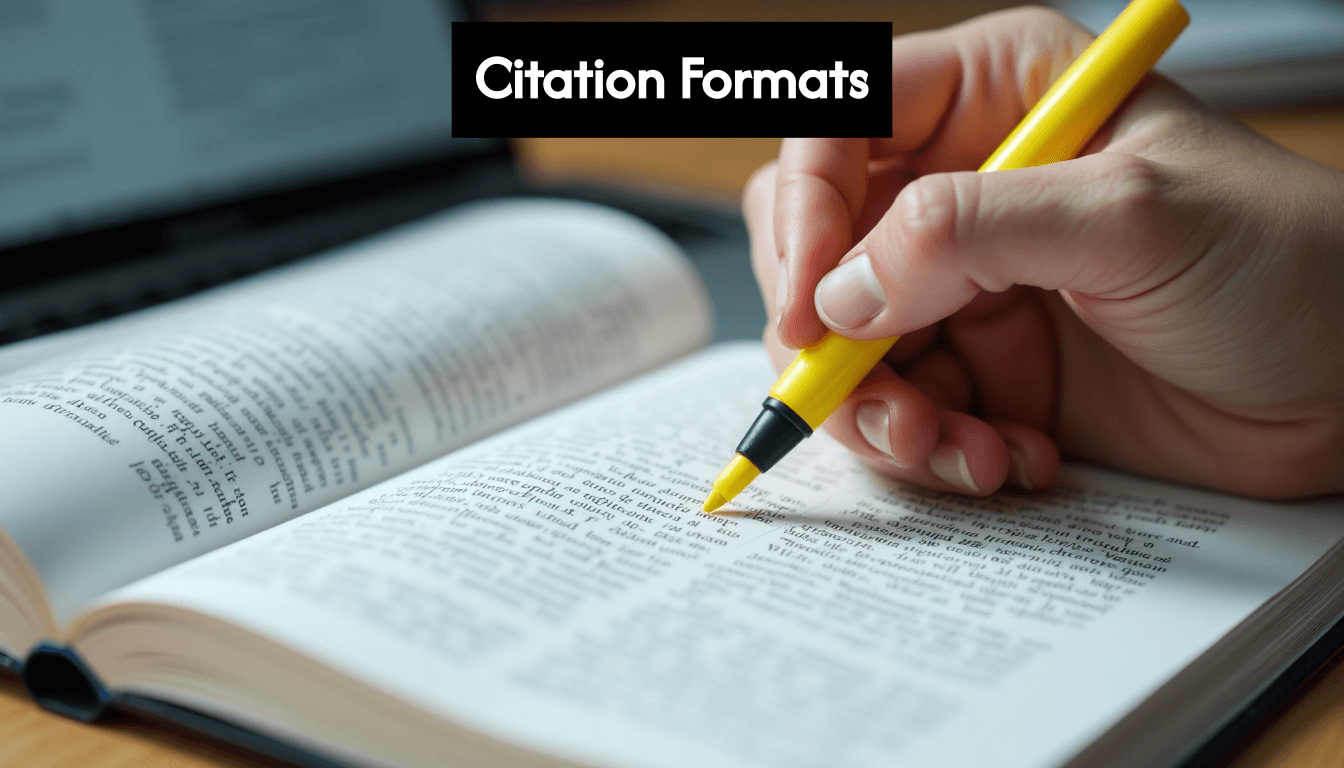Blog
Learning Materials
APA How to Cite In Text: Complete 2025 Guide for Students & Educators
Updated: June 27, 2025

APA in-text citation rules might sound simple, but plenty of students and educators still get tripped up by the details. Here’s something you might not expect. Research shows mismatched citations and reference lists are among the top reasons academic papers lose credibility. Most guides focus on formatting, but few reveal just how much a seamless citation can affect your work’s authority and trustworthiness. So how do you get it right every time and avoid the most common pitfalls?
Table of Contents
- Understanding The Fundamental Apa Citation Structure
- Navigating Complex Citation Scenarios
- Integrating Citations Seamlessly
- Print And Traditional Source Citations
- Digital And Online Source Citations
- Special Citation Scenarios
- Mismatched Citations And Reference List
- Incorrect Author Citation Formats
- Overlooking Crucial Citation Details
- Single Author And Single Source Citations
- Multiple Authors And Complex Source Citations
- Digital And Specialized Source Citations
Quick Summary
| Takeaway | Explanation |
|---|---|
| Understand the Fundamental APA Citation Structure | APA in-text citations require the author's last name, the publication year, and page number for direct quotes to enable source identification and enhance academic integrity. |
| Differentiate Between Source Types for Citations | The citation format varies by source type—print sources, digital content, and specialized materials each have unique requirements that must be followed for accurate attribution. |
| Avoid Common In-Text Citation Mistakes | Ensure all in-text citations correspond with the reference list and that author citation formats are used correctly to maintain credibility in academic writing. |
| Master Complex Citation Scenarios | When dealing with multiple authors or unique source types, adhere to specific APA rules—such as using "et al." for three or more authors—to ensure clarity and precision in citations. |
| Integrate Citations Seamlessly into Text | Citations should flow naturally within the narrative, distinguishing between parenthetical and narrative citations to improve readability while maintaining proper attribution. |

APA In-Text Citation Basics and Rules
APA in-text citations are a critical component of academic writing that help researchers properly acknowledge the intellectual contributions of other scholars. Understanding these citation rules ensures academic integrity and provides clear attribution for sources used in research papers, essays, and academic documents.
Understanding the Fundamental APA Citation Structure
The core of APA in-text citation revolves around a straightforward principle: provide enough information to uniquely identify the source while maintaining readability. Academic writing guidelines from Penn State University reveal that APA citations typically include the author's last name and the publication year. When directly quoting a source, you'll also need to include the specific page number.
Here are the primary components of an APA in-text citation:
- Author's Last Name: Always the primary identifier
- Publication Year: Indicates the source's temporal context
- Page Number (for direct quotes): Helps readers locate the exact reference
For example, a standard in-text citation might look like: (Smith, 2022) or Smith (2022) discusses the emerging trends in educational technology.
Navigating Complex Citation Scenarios
Some citation scenarios require additional nuance. Columbia College research guidelines provide critical insights into handling multiple sources by the same author or publications in the same year.
When an author has multiple publications in the same year, APA requires a systematic differentiation. You'll assign lowercase letters after the year to distinguish between sources. For instance, if Smith published two papers in 2022, they would be cited as (Smith, 2022a) and (Smith, 2022b), with the reference list organized alphabetically by title.
For sources without page numbers, such as online articles or digital content, use paragraph numbers or section headings to help readers locate the referenced information. This practice ensures precision even when traditional page references are unavailable.
Integrating Citations Seamlessly
Mastering APA in-text citations is not just about following rules but about creating a smooth, academic narrative. You can integrate citations directly into your text or place them parenthetically. When mentioning an author's name in your sentence, only the year needs to appear in parentheses. When the citation is not part of the narrative flow, both author and year are enclosed in parentheses.
For researchers looking to dive deeper into citation techniques, our comprehensive guide on paragraph citations offers additional insights into creating clear, professional academic documents.
Remember, effective APA in-text citations are more than a technical requirement. They represent scholarly respect, intellectual honesty, and the collaborative nature of academic research. By carefully attributing sources, you not only avoid plagiarism but also situate your work within a broader scholarly conversation.
Citation Formats for Different Source Types
APA citation formats vary significantly depending on the type of source you are referencing. Understanding these nuanced differences is crucial for maintaining academic credibility and ensuring proper attribution across various research materials.
Print and Traditional Source Citations
Traditional print sources like books, journals, and academic publications follow the most straightforward APA in-text citation structure. Academic writing guidelines from the University of Arizona recommend using the author's last name and publication year for most print sources. For direct quotations, you must include the specific page number to help readers locate the exact text.
Examples of print source citations include:
- Single author book: (Johnson, 2019, p. 45)
- Multiple authors book: (Smith & Rodriguez, 2021, p. 112)
- Journal article: (Williams, 2022, p. 27)
When the author's name is mentioned in the text, only the year and page number (for direct quotes) appear in parentheses. This approach maintains narrative flow while providing proper attribution.
Digital and Online Source Citations
Citing digital sources requires additional consideration. Research from Penn State University libraries highlights that online sources without page numbers demand alternative location identification methods. For web pages, e-books, and online articles, use paragraph numbers, section headings, or chapter information to help readers locate the referenced content.
For sources lacking clear page or paragraph numbers, use these citation strategies:
- Websites: Include the author's last name and year (Johnson, 2022)
- E-books: Use chapter or section information (Johnson, 2022, Chapter 3)
- Online articles: Cite paragraph number if available (Johnson, 2022, para. 5)
Our comprehensive guide on research citation techniques provides deeper insights into navigating complex digital source citations.

Special Citation Scenarios
Some sources require unique citation approaches. Government documents, legal texts, and multimedia sources often need specialized treatment. When citing sources with no clear author, use the organization name or title in place of the author. For sources with multiple authors, different rules apply depending on the number of contributors.
Multi-author source citation rules:
- Two authors: List both last names (Smith & Rodriguez, 2021)
- Three or more authors: Use first author's last name followed by "et al." (Smith et al., 2021)
- Corporate or group authors: Use the full organization name for the first citation, then an abbreviated version in subsequent references
Remember that precision and consistency are key in academic writing. Each citation format aims to provide readers with enough information to locate and verify your sources. By mastering these diverse citation techniques, you demonstrate scholarly rigor and respect for intellectual property.
Common In-Text Citation Mistakes to Avoid
Academic writing demands precision, especially when it comes to in-text citations. Even experienced researchers can fall into common citation traps that undermine the credibility of their work. Understanding and avoiding these pitfalls is crucial for maintaining academic integrity and professional standards.
Mismatched Citations and Reference List
Research from academic writing experts reveals a critical error that many students and researchers make: creating a disconnect between in-text citations and the reference list. Every source mentioned in-text must have a corresponding full reference, and vice versa. This means if you cite a source parenthetically or narratively, it must appear in your reference list with complete publication details.
Common citation mismatches include:
- Citing a source in-text but omitting it from the reference list
- Including a reference list entry for a source never cited in the document
- Inconsistent author names or publication years between in-text citations and references
To avoid these errors, create a systematic approach to tracking your sources. Many researchers use reference management tools to ensure consistency and accuracy throughout their academic writing.
Incorrect Author Citation Formats
Cornerstone University's academic writing research highlights the complexity of citing multiple authors. The most frequent mistakes involve improper handling of author names in different citation scenarios.
Critical author citation rules to remember:
- For two authors, always list both last names (Smith & Johnson, 2022)
- For three to five authors, list all names in the first citation, then use et al. for subsequent citations
- For six or more authors, use et al. from the first citation
- Ensure consistent formatting of author names across all citations
Special attention is required for group or corporate authors, which have unique citation protocols. The first citation should use the full organization name, with subsequent citations using an abbreviated version.
Overlooking Crucial Citation Details
The devil is in the details when it comes to APA in-text citations. University of Utah's graduate school guidelines point out several nuanced errors that can compromise citation accuracy.
Key details often overlooked include:
- Failing to include page numbers for direct quotations
- Incorrect placement of punctuation in relation to citations
- Not differentiating between paraphrased and directly quoted content
- Omitting publication years for time-sensitive research
For researchers seeking to improve their citation skills, understanding these subtle yet significant details is crucial. A single misplaced comma or missing page number can impact the credibility of your academic work.
Remember, citations are more than just a technical requirement. They represent scholarly integrity, allowing readers to trace the intellectual lineage of your research. By meticulously avoiding these common mistakes, you demonstrate professionalism and respect for academic scholarship.
Practical Examples for Students and Researchers
Mastering APA in-text citations requires understanding nuanced application across different research scenarios. This section provides comprehensive practical examples to help students and researchers navigate complex citation challenges with confidence and precision.
Single Author and Single Source Citations
Simon Fraser University citation guidelines provide clear guidance on basic citation formats. For single-author sources, the citation process is straightforward. Consider these practical examples:
Narrative Citation Example: Rodriguez (2022) explored the emerging trends in digital communication, revealing significant shifts in professional networking strategies.
Parenthetical Citation Example: Recent studies demonstrate a transformative approach to digital communication strategies (Rodriguez, 2022).
Direct Quotation Example: Rodriguez (2022) argued that "digital communication platforms fundamentally reshape professional interactions" (p. 45).
Multiple Authors and Complex Source Citations
Columbia College research guidelines highlight the nuanced approaches for citing multiple authors. When dealing with sources featuring two, three, or more authors, specific citation rules apply:
Two-Author Citation Examples:
- Narrative: Smith and Johnson (2021) demonstrated remarkable findings in educational technology.
- Parenthetical: Recent educational technology research shows promising developments (Smith & Johnson, 2021).
Three to Five Authors (First Citation): Taylor, Martinez, Rodriguez, and Chen (2022) conducted a comprehensive study on artificial intelligence ethics. In subsequent citations, this would become Taylor et al. (2022).
Six or More Authors: Always use the first author's last name followed by "et al." in both first and subsequent citations (Williams et al., 2022).
Digital and Specialized Source Citations
Penn State University libraries offer insights into citing digital and specialized sources. Online sources, e-books, and multimedia content require specific citation strategies:
Website Citation Example: According to the World Health Organization (2023), global health trends are rapidly evolving.
E-book Citation Without Page Numbers: Mossler (2013, Adult Development section, para. 3) explored intricate aspects of psychological development.
For researchers seeking advanced citation techniques, understanding these nuanced examples is crucial. Each citation scenario demands careful attention to detail.
Remember that context matters. While these examples provide a robust framework, always consult the latest APA style guidelines and consider the specific requirements of your academic institution or publication. Precision in citation is not just about following rules but demonstrating scholarly respect and intellectual integrity.
Mastering these citation techniques transforms complex documentation into a clear, professional representation of your research journey.
Frequently Asked Questions
How do I create an APA in-text citation?
To create an APA in-text citation, include the author's last name and the publication year. For direct quotes, also include the page number. For example, (Smith, 2022) or Smith (2022) discusses...
What if a source has multiple authors in APA citation?
For two authors, list both last names (Smith & Johnson, 2021). For three to five authors, cite all names in the first citation and use 'et al.' for subsequent citations. For six or more authors, use 'et al.' from the first citation.
How do I cite online sources with no page numbers?
If a source lacks page numbers, use paragraph numbers, section headings, or chapter information to help readers locate the reference. For example, (Johnson, 2022, para. 5) or (Johnson, 2022, Chapter 3).
What common mistakes should I avoid in APA citations?
Common mistakes include mismatched citations and references, incorrect author formats, and overlooking details like page numbers for direct quotes. Ensure all in-text citations match the reference list.
Tired of Losing Credibility Over Small APA Citation Errors?
Every detail matters when it comes to APA in-text citations. Missing a page number or misformatting an author name can instantly undermine your hard work and shake your professors' trust. The article above spotlights how overlooked citation mistakes like mismatched reference lists or complex multi-author rules are the top reasons academic papers lose authority. If you have ever worried about missing a tiny detail that ruins your essay’s credibility or worried about keeping up with changing standards, there is a better way.

Take control of your academic writing and citations today. Samwell.ai combines smart AI technology with deep knowledge of APA and MLA rules to catch tricky citation errors before they cost you. Use easy tools like the 'Power Editor' for advanced checks and real-time AI detection so your next essay is smooth, credible, and plagiarism-free, each time you write.
Ready for your highest-quality essay ever? Visit Samwell.ai and experience seamless, confident academic writing now. Or jump into our guided essay strategies for more smart writing solutions.
Recommended Articles
Generate essays with Samwell.ai
Whether you’re a publisher, professor, journalist, or student, let us tailor a plan just for you.Most Read Articles

Your Guide to Help Writing a Essay Successfully
Expert tips for help writing a essay - from crafting a thesis to structuring your essay effectively.

How to Write Critical Thinking Essay: Expert Tips
Expert tips for writing a critical thinking essay. Learn how to structure, choose topics, and use evidence effectively.'

How to Write a Good Hook: A Step-by-Step Guide
Master the art of crafting a good hook with our guide. Create compelling openers for a memorable first impression.
